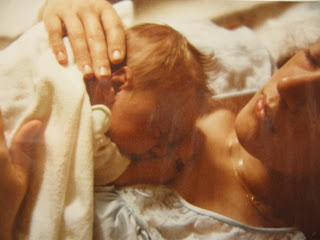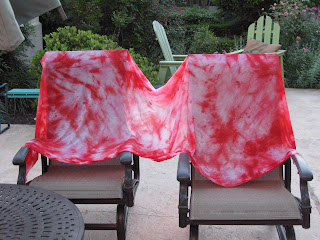After dyeing and pressing my large (3 yards long by 54 inches wide) piece of satin organza, I needed to apply fusible before shipping it to Austin. I thought I would share my technique for fusing a large piece of sheer cloth with no "lines" or wrinkled fusible.
First, I have a wide ironing board, but this would be so much better if done on a larger, squared-off pressing surface. Someday I will make a dedicated ironing surface for this very thing.
I'm fusing from a 20 inch roll of MistyFuse. I think fusing lengths of cloth off a roll is easier, but any situation will work. The important thing is to have two large teflon sheets or two lengths of parchment that are larger than the width of the roll of fusible.
I begin with the cloth hanging over the opposite edge of my ironing surface from where I am standing. With organza, since it is a little squirrely before being stabilized, I pin the leading edge to the ironing board and line up the edge of the cloth parallel to the edge of the unrolled fusible. Once the first section has been fused, it becomes easier to work with.
I fuse from the right edge of the fabric first. I have already fused the entire length of the cloth, turned it 180 degrees, and now I'm fusing the second length.
It didn't occur to me to photograph the process until this point!
Note that I have the fusible positioned so it is resting, or almost teetering, over
the edge of the ironing board.
A teflon Goddess sheet is both under and over the cloth fusible sandwich. These are available for purchase from MistyFuse! I go close to, but not up to the edge of my pressing area. Allow the fusible to cool completely before attempting to separate the pressing sheet from the fusible. I recommend moving from the right edge, and peel the edge carefully before anything else. I pull the teflon directly back upon itself to minimize lifting of the fusible.
Once the teflon has been removed, I carefully move the entire piece of cloth
and the roll of MistyFuse, forward on the ironing board.
Remember to allow cooling before doing this.
MistyFuse is very sheer, and therefore a bit more susceptible to heat exposure radiating up from the pressing surface. Once you get the rhythm, it becomes second-nature!
Now I'm rolling the MistyFuse onto the sheer.
(Note: I have already done the first length, and now I've turned the cloth around and continue to work from the right edge. I'm "matching" up the edge of the previous length of fusible to the newly rolled out edge, on the left. Good lighting on the area is very helpful. I'm trying to minimize any gaps or overlays in the fusible.
After matching the left edge to the already fused sheer
I lay the Goddess sheet in place
I move from center to edge, both directions, moving the iron continuously
Here is the cloth, fused side up.
The fusible side of a sheer will always have more "sheen".
The other side will look just as though it has no fusible under it.
MistyFuse is an amazing product for any type of cloth, but the best thing about it is how it behaves under sheers. There is nothing else like it. Here is an example of a quilt I made using MistyFuse. This quilt has so much more depth because the beautiful sheers allow the viewer to see deeper.

The dark pieces are organza with MistyFuse.
Take a look at the detail because you simply cannot see the sheer beneath!

Earlier, I stated that I like to minimize gaps and overlays in the sheer. Here is a specific circumstance when this is an issue. This is an extreme demo to show how amazing MistyFuse really is:
First, I fused two squares of MistyFuse to overlap one another in the center on the bronze organza, and I placed it in my window to back-light it:

The areas where the second strip of organza is fused make the MistyFuse invisible!
The only area that you can see the MistyFuse is the single layer of organza, and this is under extreme conditions.
The next image is the same piece of cloth without the back-lighting:

As you can see, the MistyFuse, even though there is an obvious size differential, virtually disappears.
The next image is of the purple organza, seen in the above image.
This cloth is a single sheer with 6 smaller pieces of organza fused to it with MistyFuse:

This is pretty crude and quickly slapped together, but you can see the gorgeous possibilities
where a sheer is exposed to back-lighting. Wow!
Here is a link to the website. Please tell Iris I sent you!











































